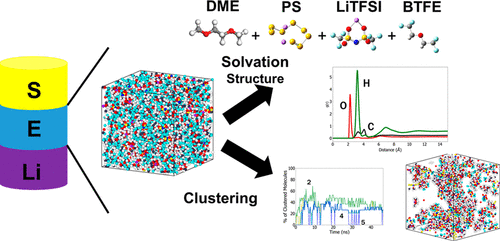当前位置:
X-MOL 学术
›
J. Phys. Chem. C
›
论文详情
Our official English website, www.x-mol.net, welcomes your
feedback! (Note: you will need to create a separate account there.)
Localized High Concentration Electrolyte and Its Effects on Polysulfide Structure in Solution
The Journal of Physical Chemistry C ( IF 3.3 ) Pub Date : 2021-09-08 , DOI: 10.1021/acs.jpcc.1c04559 Ethan P. Kamphaus 1 , Perla B. Balbuena 1
The Journal of Physical Chemistry C ( IF 3.3 ) Pub Date : 2021-09-08 , DOI: 10.1021/acs.jpcc.1c04559 Ethan P. Kamphaus 1 , Perla B. Balbuena 1
Affiliation

|
Lithium–sulfur batteries (LiSB) are a promising next-generation lithium energy storage technology that offers a multifold improvement over the traditional lithium-ion battery. However, the LiSB still faces the unresolved issue of the polysulfide shuttle effect. This phenomenon arises from the dissolution of sulfur intermediate reduction products into the electrolyte, which then causes a cascade of issues throughout the battery. Many mitigation strategies have been proposed to counteract this effect including the use of novel electrolyte compositions. Recently, there has been increased focus on the use of hydrofluorinated ethers as a major constituent of an electrolyte for lithium batteries. Previous studies have reported that the presence of these species create localized high concentration electrolytes (LHCE) which can have many advantages resulting in improved battery performance. Here, we report on how the inclusion of a hydrofluorinated ether BTFE (bis(2,2,2-trifluoroethyl) ether) modifies the general properties of a LiSB electrolyte and the structure of dissolved polysulfide species in the electrolyte. We found that the inclusion of BTFE does not modify the primary solvation structure of Li+ directly but actively participates in secondary solvation shells. With a high concentration of BTFE, the LHCE formation is observed by the presence of clusters of non-BTFE molecules. The structure of polysulfide species in solution was modified by the BTFE in the same way. Much of the primary solvation structure was kept, but the presence of BTFE increased polysulfide–polysulfide clustering. These results indicate that the polysulfide solubility will be limited due to the promotion of clustering.
中文翻译:

局部高浓度电解质及其对溶液中多硫化物结构的影响
锂硫电池(LiSB)是一种很有前途的下一代锂储能技术,与传统的锂离子电池相比,它具有多方面的改进。然而,LiSB 仍然面临着未解决的多硫化物穿梭效应问题。这种现象是由于硫中间还原产物溶解到电解液中而引起的,这会导致整个电池的一系列问题。已经提出了许多缓解策略来抵消这种影响,包括使用新型电解质组合物。最近,人们越来越关注使用氢氟醚作为锂电池电解质的主要成分。之前的研究报告称,这些物质的存在会产生局部高浓度电解质 (LHCE),它具有许多优势,可提高电池性能。在这里,我们报告了包含氢氟醚 BTFE(双(2,2,2-三氟乙基)醚)如何改变 LiSB 电解质的一般性质和电解质中溶解的多硫化物物质的结构。我们发现包含 BTFE 不会改变锂的主要溶剂化结构+直接但积极地参与二级溶剂化壳。对于高浓度的 BTFE,通过非 BTFE 分子簇的存在观察到 LHCE 的形成。溶液中多硫化物的结构也以同样的方式被 BTFE 修饰。大部分主要溶剂化结构得以保留,但 BTFE 的存在增加了多硫化物-多硫化物的聚集。这些结果表明多硫化物的溶解度将由于聚集的促进而受到限制。
更新日期:2021-09-23
中文翻译:

局部高浓度电解质及其对溶液中多硫化物结构的影响
锂硫电池(LiSB)是一种很有前途的下一代锂储能技术,与传统的锂离子电池相比,它具有多方面的改进。然而,LiSB 仍然面临着未解决的多硫化物穿梭效应问题。这种现象是由于硫中间还原产物溶解到电解液中而引起的,这会导致整个电池的一系列问题。已经提出了许多缓解策略来抵消这种影响,包括使用新型电解质组合物。最近,人们越来越关注使用氢氟醚作为锂电池电解质的主要成分。之前的研究报告称,这些物质的存在会产生局部高浓度电解质 (LHCE),它具有许多优势,可提高电池性能。在这里,我们报告了包含氢氟醚 BTFE(双(2,2,2-三氟乙基)醚)如何改变 LiSB 电解质的一般性质和电解质中溶解的多硫化物物质的结构。我们发现包含 BTFE 不会改变锂的主要溶剂化结构+直接但积极地参与二级溶剂化壳。对于高浓度的 BTFE,通过非 BTFE 分子簇的存在观察到 LHCE 的形成。溶液中多硫化物的结构也以同样的方式被 BTFE 修饰。大部分主要溶剂化结构得以保留,但 BTFE 的存在增加了多硫化物-多硫化物的聚集。这些结果表明多硫化物的溶解度将由于聚集的促进而受到限制。





















































 京公网安备 11010802027423号
京公网安备 11010802027423号